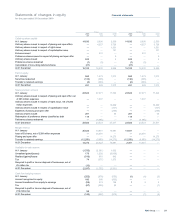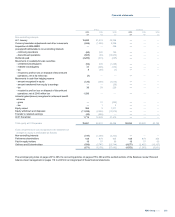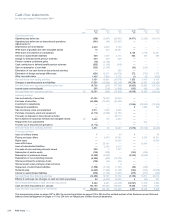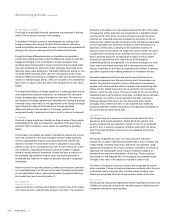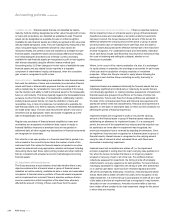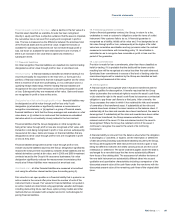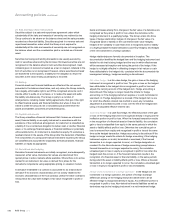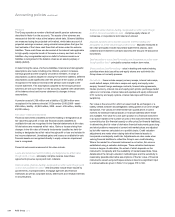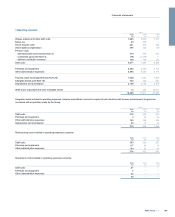RBS 2010 Annual Report Download - page 283
Download and view the complete annual report
Please find page 283 of the 2010 RBS annual report below. You can navigate through the pages in the report by either clicking on the pages listed below, or by using the keyword search tool below to find specific information within the annual report.
Financial assets carried at fair value - when a decline in the fair value of a
financial asset classified as available-for-sale has been recognised
directly in equity and there is objective evidence that the asset is impaired,
the cumulative loss is removed from equity and recognised in profit or
loss. The loss is measured as the difference between the amortised cost
of the financial asset and its current fair value. Impairment losses on
available-for-sale equity instruments are not reversed through profit or
loss, but those on available-for-sale debt instruments are reversed, if
there is an increase in fair value that is objectively related to a
subsequent event.
17. Financial liabilities
On initial recognition financial liabilities are classified into held-for-trading;
designated as at fair value through profit or loss; or amortised cost.
Held-for-trading - a financial liability is classified as held-for-trading if it is
incurred principally for repurchase in the near term, or forms part of a
portfolio of financial instruments that are managed together and for which
there is evidence of short-term profit taking, or it is a derivative (not in a
qualifying hedge relationship). Held-for-trading financial liabilities are
recognised at fair value with transaction costs being recognised in profit
or loss. Subsequently they are measured at fair value. Gains and losses
are recognised in profit or loss as they arise.
Designated as at fair value through profit or loss - financial liabilities may
be designated as at fair value through profit or loss only if such
designation (a) eliminates or significantly reduces a measurement or
recognition inconsistency; or (b) applies to a group of financial assets,
financial liabilities or both that the Group manages and evaluates on a fair
value basis; or (c) relates to an instrument that contains an embedded
derivative which is not evidently closely related to the host contract.
Financial liabilities that the Group designates on initial recognition as
being at fair value through profit or loss are recognised at fair value, with
transaction costs being recognised in profit or loss, and are subsequently
measured at fair value. Gains and losses on financial liabilities that are
designated as at fair value through profit or loss are recognised in profit
or loss as they arise.
Financial liabilities designated as at fair value through profit or loss
include structured liabilities issued by the Group: designation significantly
reduces the measurement inconsistency between these liabilities and the
related derivatives carried at fair value; and in 2009 and 2008 investment
contracts issued by the Group's life assurance businesses: fair value
designation significantly reduces the measurement inconsistency that
would arise if these liabilities were measured at amortised cost.
Amortised cost - all other financial liabilities are measured at amortised
cost using the effective interest method (see Accounting policy 3).
Fair value for a net open position in a financial liability that is quoted in an
active market is the current offer price times the number of units of the
instrument held or issued. Fair values for financial liabilities not quoted in
an active market are determined using appropriate valuation techniques
including discounting future cash flows, option pricing models and other
methods that are consistent with accepted economic methodologies for
pricing financial liabilities.
18. Financial guarantee contracts
Under a financial guarantee contract, the Group, in return for a fee,
undertakes to meet a customer’s obligations under the terms of a debt
instrument if the customer fails to do so. A financial guarantee is
recognised as a liability; initially at fair value and, if not designated as at
fair value through profit or loss, subsequently at the higher of its initial
value less cumulative amortisation and any provision under the contract
measured in accordance with Accounting policy 13. Amortisation is
calculated so as to recognise fees receivable in profit or loss over the
period of the guarantee.
19. Loan commitments
Provision is madefor loan commitments, other than those classified as
held-for-trading, if it is probable that the facility will be drawn and the
resulting loan will be recognised at a value less than the cash advanced.
Syndicated loan commitments in excess of the level of lending under the
commitment approved for retention by the Group are classified as held-
for-trading and measured at fair value.
20. Derecognition
Afinancial asset is derecognised when it has been transferred and the
transfer qualifies for derecognition. A transfer requires that the Group
either (a) transfers the contractual rights to receive the asset's cash flows;
or (b) retains the right to the asset's cash flows but assumes a contractual
obligation to pay those cash flows to a third party. After a transfer, the
Group assesses the extent to which it has retained the risks and rewards
of ownership of the transferred asset. If substantially all the risks and
rewards have been retained, the asset remains on the balance sheet. If
substantially all the risks and rewards have been transferred, the asset is
derecognised. If substantially all the risks and rewards have been neither
retained nor transferred, the Group assesses whether or not it has
retained control of the asset. If it has not retained control, the asset is
derecognised. Where the Group has retained control of the asset, it
continues to recognise the asset to the extent of its continuing
involvement.
Afinancial liability is removed from the balance sheet when the obligation
is discharged, or cancelled, or expires. On the redemption or settlement
of debt securities (including subordinated liabilities) issued by the Group,
the Group derecognises the debt instrument and records a gain or loss
being the difference between the debt's carrying amount and the cost of
redemption or settlement. The same treatment applies where the debt is
exchanged for a new debt issue that has terms substantially different
from those of the existing debt. The assessment of whether the terms of
the new debt instrument are substantially different takes into account
qualitative and quantitative characteristics including a comparison of the
discounted present value of the cash flows under the new terms with the
discounted present value of the remaining cash flows of the original debt
issue.
281RBS Group 2010
Financial statements


